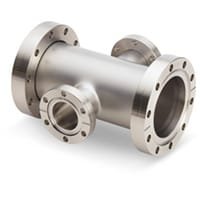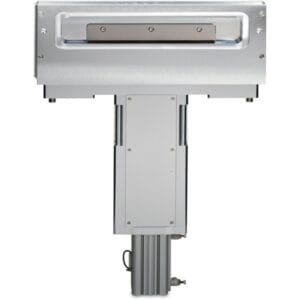ConFlat (CF) UHV 4-Way Reducer Crosses and Cubes by TFM
At TFM, we offer a precision-engineered selection of ConFlat (CF) UHV 4-Way Reducer Crosses and Cubes, manufactured from high-purity 304L stainless steel tubing. These components are purpose-built for ultra-high vacuum (UHV) systems, delivering consistent, leak-tight performance in demanding scientific and industrial environments. Each assembly incorporates knife-edge sealing flanges in line with the ConFlat (CF) standard—widely trusted for their vacuum integrity and durability.
Key Features of ConFlat (CF) UHV Crosses and Cubes
✔ 4-Way Reducer Crosses with Rotatable Flanges
Our CF UHV 4-Way Reducer Crosses feature rotatable ConFlat flanges on each axis, making them highly adaptable for complex vacuum configurations. The reducer-style layout supports transitions between different flange sizes while maintaining structural and vacuum compatibility.
✔ Through-Hole Bolt Flanges for Stability
These crosses are equipped with through-hole bolt patterns, providing secure and vibration-resistant mounting. This design ensures structural reliability and helps maintain vacuum levels under mechanical or thermal stress.
✔ Tapped Side Ports for Cubes
The CF cubes include tapped sides that accommodate direct mounting of gauges, viewports, feedthroughs, and other UHV-compatible components. Their modular nature makes them ideal for expanding or customizing UHV setups.
Built for Compatibility and Performance
TFM’s ConFlat (CF) UHV 4-Way Reducer Crosses and Cubes are designed for seamless integration with a wide variety of UHV hardware—from ion gauges and electrical feedthroughs to viewport windows and vacuum pumps. The use of 304L stainless steel not only ensures excellent mechanical properties but also minimizes outgassing for consistent long-term vacuum operation.
Ordering Table
| Flange Size/OD (Large) | Note | Part Number |
| DN35CF-DN40CF (2.75" OD) | — | C-0275-133 |
| DN35CF-DN40CF (2.75" OD) | — | C-0275-212 |
| DN50CF (3.38" OD) | — | C-0337-133 |
| DN50CF (3.38" OD) | — | C-0337-275 |
| DN63CF (4.50" OD) | — | C-0450-275 |
| DN63CF (4.50" OD) | — | C-0450-337 |
| DN75CF (4.63" OD) | — | C-0462-337 |
| DN75CF (4.63" OD) | — | C-0462-450 |
| DN100CF (6.00" OD) | — | C-0600-275 |
| DN100CF (6.00" OD) | C-0600-337 | |
| DN100CF (6.00" OD) | — | C-0600-450 |
| DN160CF (8.00" OD) | — | C-0800-275 |
| DN160CF (8.00" OD) | — | C-0800-450 |
| DN160CF (8.00" OD) | — | C-0800-600 |
| DN200CF (10.00" OD) | — | C-1000-800 |





Reviews
There are no reviews yet.